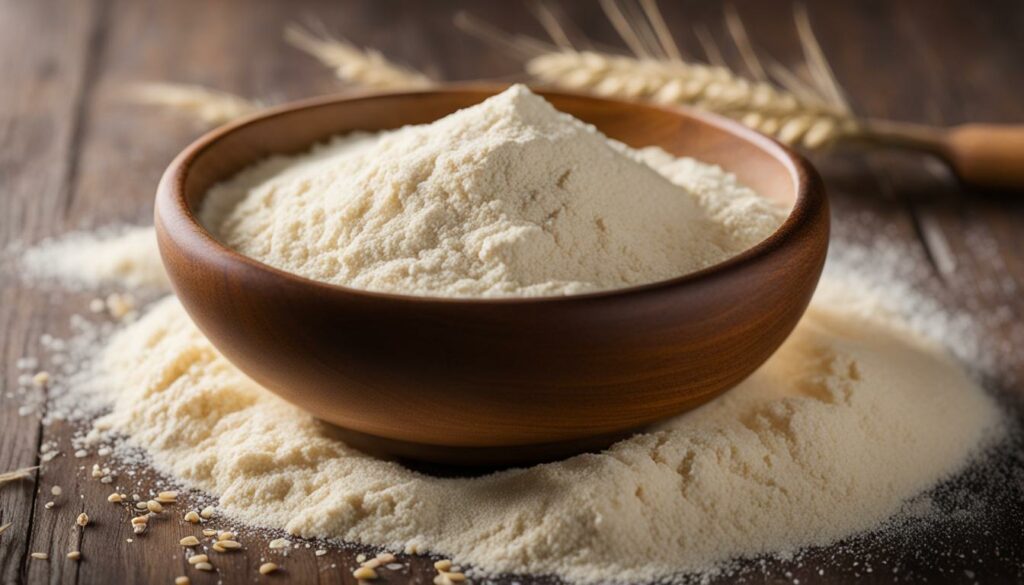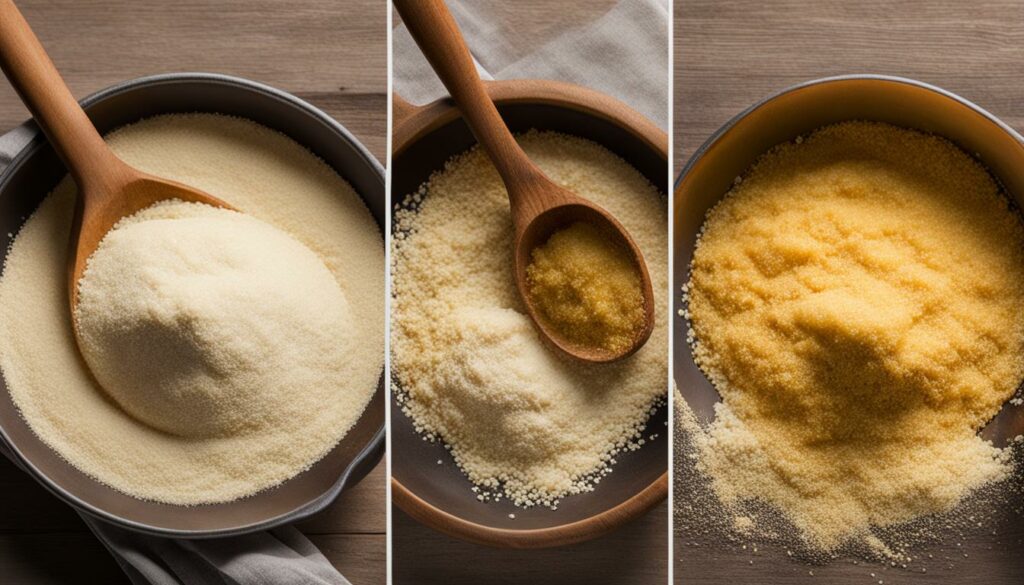Have you ever wondered about the differences between semolina and farina, two grains commonly found in most pantries? These versatile ingredients may seem similar at first glance, but understanding their distinctions can help you choose the right grain for your cooking needs.
Semolina and farina have different textures and consistencies, making them more suitable for certain recipes than others. In this article, we’ll explore the differences between semolina and farina, and how they can best fit into your kitchen.
Key Takeaways:
- Semolina and farina are two common grains found in most pantries.
- The main difference between the two is their texture and consistency.
- Semolina has a coarser texture and is perfect for pasta and couscous dishes, while farina is softer and better suited to porridge and pudding recipes.
- Both semolina and farina are versatile ingredients that can add nutrition and flavor to your meals.
- Understanding the differences between the two grains can help you choose the right one for your cooking needs.
What is Semolina?
If you’re a fan of pasta dishes or Moroccan cuisine, then you’re probably familiar with semolina. Semolina is a coarse flour made from durum wheat, one of the hardest types of wheat available. It is commonly used in pasta and couscous due to its high gluten content, which gives these dishes their distinctive chewy texture.
Semolina is also rich in protein and fiber, making it a nutritious choice for your meals. In fact, a 1/4 cup serving of semolina contains approximately:
| Nutrient | Amount |
|---|---|
| Protein | 3 grams |
| Fiber | 2 grams |
| Iron | 4% of the daily value |
Aside from pasta and couscous, semolina can also be used to make breads, puddings, and even pizza crust. With its unique texture and nutritional benefits, semolina is a versatile ingredient to have in your pantry.
Exploring Farina

If you often cook with flour at home, you might have come across farina in your pantry. This wheat-based product is a staple ingredient in many kitchens and is used in a variety of dishes.
Farina is a fine flour made from wheat, and it is often used to make porridge and pudding. When cooked, farina has a smooth and creamy texture that works well in sweet desserts. Unlike semolina, farina is not as high in gluten, which gives it a different consistency when used in recipes.
Farina is a versatile ingredient, and you can use it in many different ways in your cooking. It can be used to thicken soups and stews, or in place of breadcrumbs for coating meat. It can also be used as a substitute for flour in baking recipes.
Farina Nutrition Facts
| Nutrient | Amount per Serving |
|---|---|
| Calories | 130 |
| Total Fat | 0.5g |
| Sodium | 0mg |
| Total Carbohydrate | 27g |
| Dietary Fiber | 1g |
| Protein | 4g |
As you can see from the table, farina is a good source of nutrients and is relatively low in calories. It is high in carbohydrates, making it a great option for a quick burst of energy. Farina is also rich in protein, which is essential for building and repairing muscles.
If you are looking for a nutritious ingredient that can be used in many different ways in your cooking, farina is a great choice. It is easy to find in most grocery stores, and it is a budget-friendly option that can be used in a variety of dishes.
Semolina vs Farina: Texture, Usage, and Recipes

Now that we’ve explored the key differences between semolina and farina, let’s dive deeper into texture, usage, and recipes.
Texture
Semolina provides a grainy and slightly coarse texture, making it perfect for pasta and couscous dishes. When cooked, semolina-based products have a distinct chewiness that adds a delightful texture to your meals. On the other hand, farina offers a smoother and softer texture, making it ideal for porridge and pudding recipes.
Usage
Semolina and farina can both be used in a variety of dishes. Semolina is commonly used in pasta and couscous dishes due to its high gluten content, while farina is often used to make porridge and pudding due to its smooth texture when cooked. However, both grains can also be used in other recipes. For example, you can use semolina to make cakes and bread, or use farina to make cookies and cakes.
Recipes
If you’re looking to incorporate semolina into your cooking, you can try making homemade pasta or couscous. Here’s a simple recipe for homemade pasta:
Homemade Semolina Pasta
| Ingredients | Instructions |
|---|---|
| 2 cups semolina flour | 1. In a large bowl, mix the semolina flour and 1/2 cup of warm water until a dough forms. |
| 1/2 teaspoon salt | 2. Knead the dough for 10 minutes, then cover and let rest for 30 minutes. |
| 3 large eggs | 3. Roll out the dough and cut into desired shapes for your pasta. |
If you want to use farina in your cooking, you can try making Cream of Wheat porridge. Here’s a simple recipe:
Cream of Wheat Porridge
| Ingredients | Instructions |
|---|---|
| 1 cup farina | 1. In a medium saucepan, bring 3 cups of water to a boil. |
| 3 cups water | 2. Gradually whisk in the farina and salt, then reduce the heat to low. |
| 1/4 teaspoon salt | 3. Cook, stirring frequently, for 2-3 minutes or until the porridge thickens. Serve hot with milk and brown sugar. |
Whether you’re using semolina or farina, both grains can add a unique and delicious touch to your meals. Experiment with different recipes and enjoy the versatility and flavors of these pantry staples.
Semolina vs Farina
After exploring the differences between semolina and farina, it’s clear that both grains have their unique characteristics and are used in different culinary creations.
Semolina provides a grainy and slightly coarse texture, making it perfect for pasta and couscous dishes. Farina, on the other hand, offers a smoother and softer texture, making it ideal for porridge and pudding recipes.
When deciding which grain to use, consider the texture and consistency you want for your dish. If you’re making pasta or couscous, semolina is the way to go. But if you’re in the mood for a creamy and smooth porridge or pudding, farina is the better choice.
It’s worth noting that both semolina and farina are nutritious ingredients and a great addition to any pantry. They’re both made from wheat and provide a good source of protein and fiber. So, feel free to experiment with both grains in your cooking!
Final Thoughts
In conclusion, the choice between semolina and farina ultimately comes down to your personal preference and the recipe you’re making. Don’t be afraid to try out both grains and see which one you prefer for different dishes. With their versatility and unique characteristics, both semolina and farina are great options to have in your pantry.